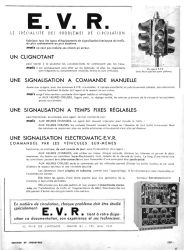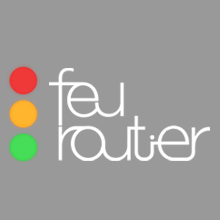
DOCUMENTS
historic




Italian signals from SCAE
Isotrafic controllers
Electromatic traffic controller 1952

signal in Paris

Minerve signals in Nice (1986)

Strasbourg in 1952

The Eclairage des Vehicules sur Rail (EVR) company was founded in 1919 by a group of companies made up of the Compagnie Générale d'Électricité (CGE), the Compagnie des Magnetos, the Tudor Accumulator and the Société pour l'Équipement des Véhicules (SEV). At that time, its activity was exclusively devoted to the design, manufacture, installation and maintenance of lighting fixtures for trains. More than 15,000 EVR devices will be in service in 1930, and these products are exported throughout Europe, Asia and South America.
In 1934, Robert Blancherie became head of the EVR, and over the years became the emblematic leader of the company. The same year, he acquired an Anglo-American license from the manufacturer Automatic Signal Division, which authorized him to market "Electro-Matic" electromechanical intersection controllers, as well as a traffic light model. The first EVR installation will take place in 1935, with the equipment of the Place de la Trinité in Paris.
At the end of the 1930s, rail activity diversified (high-power generators for heating trains, heat engine equipment, air conditioning), while traffic activity developed. But the Second World War will put a brake on the development of the company which will then specialize in the manufacture of batteries for electric trucks in order to compensate for the shortage of gasoline.
As early as 1943, Robert Blancherie actively approached the Commissariat for Reconstruction and questioned it on the need to set up traffic control equipment. This solicitation will prove to be profitable, and the traffic activity of EVR will explode at the end of the 1940s with the equipment of the main French cities (Paris, Toulouse, Nice, Reims...). Actively supported by its parent companies, EVR will be able to produce a large number of traffic lights, but also to develop this activity, and in particular the problem of road traffic regulation.
In the 1960s, EVR developed its activity a little further, with the production of fluorescent tube lighting for aircraft (more than 2,000 units for the Caravelle), vehicle counting and toll collection products (Escota motorway in 1961), light signaling (terminals, backlit panels), and coordination of intersections with traffic lights.
The 1970s saw the introduction of centralized controls at intersections, which allowed remote controllers to self-adjust according to traffic density using sensors (Nice in 1971, Toulouse in 1975). In 1972, 220 EVR electromechanical controllers were in service in Paris, and the following year the Isotrafic controller, the first static electronic control unit, was presented (150 intersections equipped with Isotrafic in 1975). In 1971, the Paris headquarters of EVR rue de l'Arcade was transferred to Aubervilliers in a building custom-built by the architect François Emery. The building is now listed in the heritage atlas of Seine Saint Denis. At the same time, the railway branch was known for supplying South Africa with clearly designated transport wagons, from the French factory, for white travelers only, which earned EVR a place among the companies that participated. to Apartheid.
The 1980s marked the very clear decline of EVR, which was faced with both the decline of its railway activity and overwhelming competition in the field of traffic signals. At the end of the 1980s, the commercialization of Classic aluminum traffic lights, very robust and whose reputation is well established, was still active, however plastic traffic lights with a more elaborate design were in fashion, in particular thanks to the lines street furniture developed by the advertiser JCDecaux. EVR then released two new traffic lights, Minerva in plastic and Minerva in aluminium, which were to be very successful.
EVR disappeared in 1995 when the company was bought by the Lacroix group. The traffic lights and controllers developed by EVR for nearly 60 years will continue to be marketed by Sofrel, a subsidiary of the Lacroix group, before being integrated into Lacroix Trafic and being gradually replaced during the 2000s.
THE DOCUMENTATION OF CONTROLLERS ARE AVAILABLE ON THE PAGE "CONTROLLERS"
EVR ad - 1967

EVR ad - 1972



PRODUCTS


EVR ad - 1948
EVR letter - 1950








EVR factory in 1936




the website
about
French traffic lights



©2006-2023 | Conception : Hugo MAILLET - all rightd reserved | Companies and brands represented belong to their respective owner